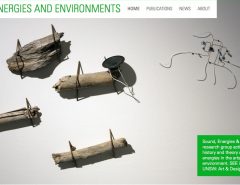Composer: Hildegard Westerkamp
Photographer: Florence Debeugny
Listen
[audio:http://www.sfu.ca/~westerka/mp3s/edge_wilderness.mp3]
When resource industry moves into British Columbia’s landscapes, industrial sites and company towns are cut into the wilderness. The edge between wilderness and such a new place is traditionally knife sharp like the edge between life and a stabbing death. Poison is released into the environment by the violent penetration of industry. Once resources are drained the company moves away leaving its huge, filthy footprints behind, leaving open gaps in mountains and relying on natural processes to absorb the junkheaps, trailings, the waste. Natural rhythms and movements eventually soften the edges, transforming an abandoned industrial site into mysterious rusty shapes and collapsed wooden structures overgrown by moss, weeds, shrubs, and trees. A once noisy, bustling place becomes a quiet ghosttown full of memories. An old industry becomes artifact and lies there like a toothless monster of the past.
About the Sounds
Initially, when we first arrived at the ghosttown sites, the many rusty objects and structures were lying around silently, telling us stories of their working life, of their function. But as we moved through the sites, stepping on and through them, «playing» on them, hitting them with various objects, listening, they produced the most fascinating resonances. Whether the sounds came from on an old steam engine or an out-of-tune piano with broken strings, they became the musical instruments for At the Edge of Wilderness, Exploring their acoustic/musical properties in their dillapidated state, brought them to life in surprising ways. In some cases, depending on how they were «played», they created sounds and rhythms not unlike that of old machinery from the turn of the 19th to the 20th century. They are the sounds that carry us from the presence of the existing ghosttowns into the imagined past of these places, and they delineate the particular edge that has been created between nature and this form of civilization all over the North American continent. Turning the industrial structures into musical instruments may be a way of exorcising the damage that has been done and is still being done in many cases on this continent and all over the world – a way to make peace or find a balance between the destructive and the creative forces that tend to work side by side in adventurous explorations.
List of places we visited for gathering sounds and images:
* Near Vancouver: Harrison Mills and Carnarvon, Mount Sheer behind Britannia Beach.
* In the Kootenay Lake/Slocan Lake area: Lardeau, Nashton, Manganese Mine, Whitewater Deep Mine, Iron Hand Mine, Retallack, Zincton, Rambler, Sandon, Cody, Camp Galilea, Roseberry.
* Between Kootenay Lake and Trout Lake: Marblehead, Marblehead Quarry, Poplar Creek, Gerrard.
* Near Princeton: Blakeburn mine and Granite City (Coalmont).
* Near Gold Bridge: Brandywine, Bralorne, Bradian Prairies and Pioneer.





Leave a Reply
Lo siento, debes estar conectado para publicar un comentario.